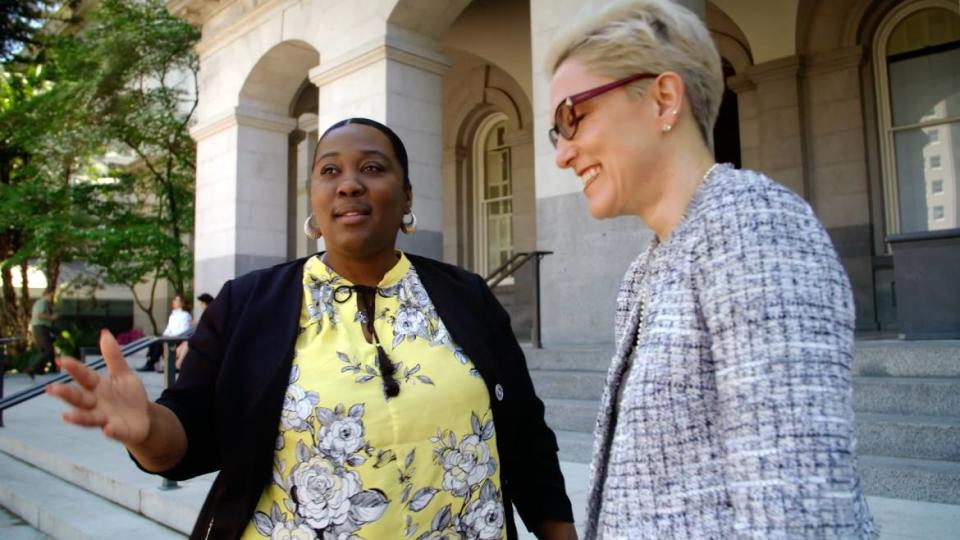Inside America’s Horrifying Modern-Day Eugenics Movement

Director Erika Cohn’s new film, Belly of the Beast, part of the Human Rights Watch Film Festival which goes digital in the U.S. from June 11 to 20, brings to the fore the undeniable and continued legacy of eugenics and forced sterilization in the state of California.
The documentary follows the case of Kelli Dillon, a black mother who was told she had cysts and needed surgery while incarcerated, only to discover, over a year later and after months of menopausal symptoms and extreme weight loss at the age of 24, that she had been given a hysterectomy (Dillon’s doctors never told her they had performed a hysterectomy on her). Risking retaliation, Dillon decided to speak out even while she was still in jail and teamed up with the prison abolition legal aid organization Justice Now, founded by attorney Cynthia Chandler, to find justice. Belly of the Beast is about the freedom work Dillon, Chandler, and the Justice Now team—whose board members are all currently incarcerated women—do against all odds in the service of female survivors of all kinds of violence, not just at home but from the state.
The Women Geniuses Taking on Racial and Gender Bias in AI—and Amazon
Thomas Piketty on Why Capitalism Isn’t Evil and Billionaires Can Still Exist
In the U.S., many regular people still believe in eugenics, particularly when it comes to the country’s enormous incarcerated population, and especially when those people are poor black women. This makes sense because the practice of eugenics was pioneered in California beginning with a 1909 law that sanctioned the sterilization of those deemed “unfit,” from poor black and Native mothers to people with mental and physical disabilities to the criminalized. In fact the Nazis borrowed their eugenics project from the U.S. and the state of California specifically. Much of what American schoolchildren are taught are evils that originated in the sick minds of Hitler, Himmler, and Goebbels in fact were first practiced by their own state officials.
To the film’s great credit, instead of performing typical liberal disbelief around the discovery that eugenic sterilization persists today, Belly of the Beast shows how the very practice springs forth from the U.S. project and white American imagination. When journalist Corey G. Johnson published his article on the present-day sterilizations-sans-consent happening in the California Department of Corrections and Rehabilitation, a deluge of racist and fascist comments came in from regular people about how (to paraphrase) “all black people should be sterilized” and performing eugenics, especially on people who are incarcerated or on welfare, is “A-OK.” This is the reality Dillon, Chandler, and organizations like Justice Now fight against: The U.S. is a country in which degrading and devaluing human life in order to “save the state funds,” as eugenics doctor-in-chief James Heinrich put it, is deemed reasonable in the court of public opinion, and even—often—in the judicial court system as well.
This is why, at the center of Belly of the Beast, the projects of prison abolition and reparations are essential. There is no reforming a system that systemically and illegally sterilizes its women in order to save the state welfare dollars. Two of the CDCR nurses interviewed in the documentary even admit they didn’t know the practice was actually banned, and had been since 1979. One of the nurses, who participated on the condition of anonymity, says that she wouldn’t have made anesthetized—in other words, drugged up—women sign their rights away if she had known it was illegal; but later, she confesses that she thinks sterilization should be legal in prisons, and that Dr. Heinrich, one of the many doctors who haphazardly and evilly carried out these sterilizations, was right to want to save the state money. The interview makes it clear that prisons are not designed to rehabilitate—quite the contrary. The other CDCR nurse underlines this point by saying that even if it had been technically legal (which it wasn’t), there’s no way for a person to consent to any major decisions while incarcerated, since prison guards and administrators have too much power over them. This is why, for example, the law deems it impossible for a person to consent to sex with a correctional officer while incarcerated. This is our U.S. correctional underworld, where you must be protected—at least technically speaking—from your own lack of rights.

In the documentary, a radio segment points out that 92 percent of incarcerated women worldwide are survivors of domestic violence and childhood abuse (the figure has been reported as somewhere between 70 and 90 percent), and a portion of these women are even incarcerated for defending themselves against their abusers. Then, after experiencing this violence at home, for years, decades, or even the remainder of their lives, these women are abused again and again by a state-designed operation. With its Department of Corrections and Rehabilitation, California, a state that often receives liberal praise and conservative ire for its progressive image, is indeed home to one of the most brutally violent organizations operating in the country today.
It’s not just Dillon, but likely hundreds of women (at minimum) in the California corrections system alone who have been forcibly sterilized and whose names were never recorded by administrators. Belly of the Beast resurfaces not only the inhumanity of what we call “rehabilitation” but also of the many online and in-real-life commenters who are extremely satisfied by their exclusive, race- and class-determined rights.
Got a tip? Send it to The Daily Beast here
Get our top stories in your inbox every day. Sign up now!
Daily Beast Membership: Beast Inside goes deeper on the stories that matter to you. Learn more.

